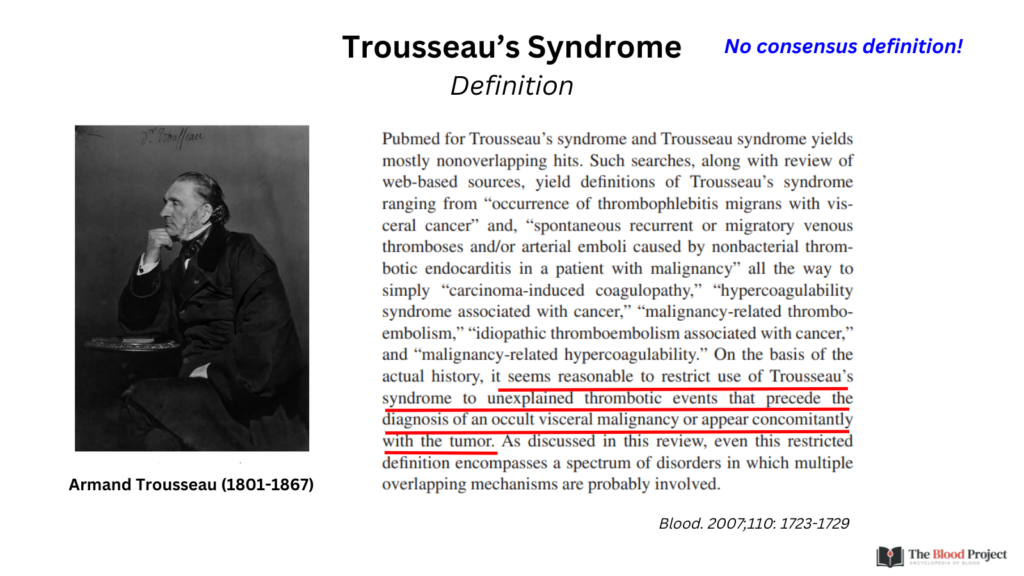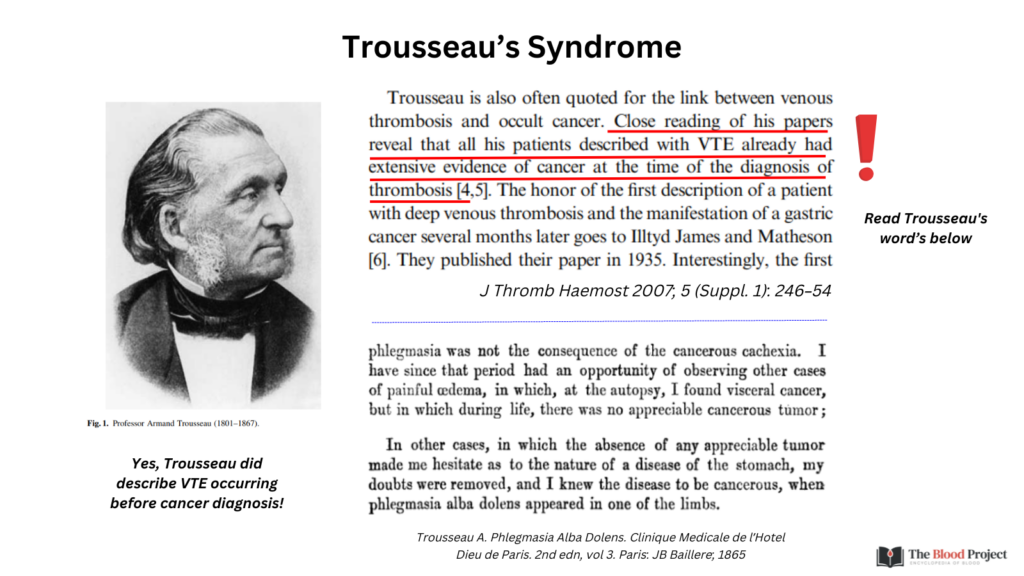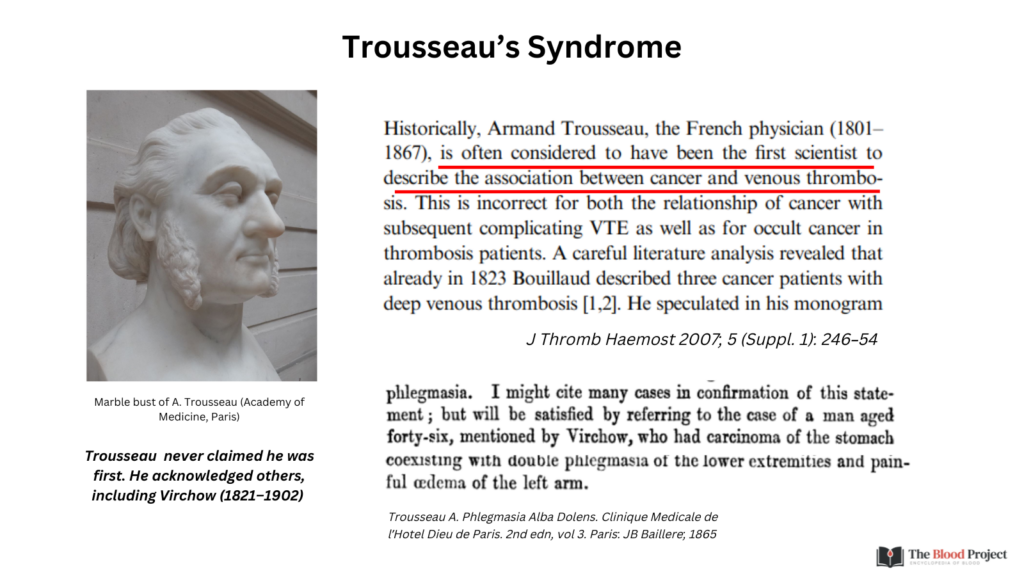- Named after Armand Trousseau (1801-1867), an internist from France, Trousseau’s syndrome lacks a consensus definition, but typically refers to an association between thrombosis and cancer.
- Armand Trousseau:
- Born in Tours in 1801, died of gastric cancer (with thrombosis) in 1867.1
- Received his MD in 1825 and became adjunct faculty in Paris in 1827.
- Practiced general medicine, building up a substantial practice.
- Appointed at the age of 38 as physician to the Hopital St. Antoine in 1839.
- Appointed physician to the Hopital St. Antoine in 1839.
- Became Chair of therapy and pharmacology at the Paris medical faculty.
- Appointed Physician-in-Chief of clinical medicine at Hotel Dieu in 1850.
- In the 1860s published Clinique Medicale do l’Hotel-Dieu, comprising a series of lectures on diseases.
- In a lecture called Phlegamsia Alba Dolens, he described the association between thrombosis and cancer (detailed below).
- Known for several eponyms:
- Trousseau’s syndrome
- Trousseau–Lallemand bodies (an archaic synonym for Bence Jones proteins)
- Trousseau sign of latent tetany,
- The originator of the term Trousseau’s syndrome is not know.
- The definition of the term has evolved over the years:
- Originally used (after Trousseau’s time) to describe migratory thrombophlebitis as a sign of visceral malignancy.
- Then expanded to include thromboembolic events involving deep or superficial veins or the arterial circulation, nonbacterial thrombotic endocarditis and DIC.2
- More recently it was proposed to “restrict use of Trousseau’s syndrome to unexplained thrombotic events that precede the diagnosis of an occult visceral malignancy or appear concomitantly with the tumor.”3
- Trousseau’s description of the association between thrombosis and cancer appears in Lecture XCV, Phlegmasia Alba Dolens:4
- “I have long been struck with the frequency with which cancerous patients are affected with painful oedema in the superior or inferior extremities.”
- “This frequent occurrence of phlegmasia alba dolens with an appreciable cancerous tumor, led me to the inquiry of whether a relationship of cause and effect did not exist between the two, and whether the phlegmasia was not the consequence of the cancerous cachexia.”
- “I have since that period had an opportunity of observing other cases of painful oedema, in which, at autopsy, I found visceral cancer, but in which during life, there was no appreciable tumor… I have thus been led to the conclusion, that when there is a cachectic state not attributable to the tuberculous diathesis nor to the puerperal state, there is most probably a cancerous tumor in some organ.”
- Case 1. Trousseau comments on a case he was asked to consult, namely a 59 yo M with left leg DVT, who was believed by his primary physician to have leucocythemia. “When consulted, I said: ‘Perhaps, this patient has leucocythemia; but he has phlegmasia alba dolens, and consequently deep seated, concealed cancer.’ At autopsy, the patient was found to have anular cancer of the pylorus.
- “In other cases, in which the absence of any appreciable tumor made me hesitate as to the nature of a disease of the stomach, my doubts were removed, and I knew the disease to be cancerous, when phlegmasia alba dolens appeared in one of the limbs.”
- Case 2. Trousseau refers to a professor the Faculty of Medicine who had symptoms of a simple stomach ulcer. He then developed phlegmasia alba dolens, whereupon Trousseau “unhesitatingly declared that he would sine under advancing cancerous disease: the rapid progress and fatal issue of the case provide my diagnosis to be correct.”
- Case 3. A man about 40 yo consulted Trousseau with pain and feeling of weight in his left leg. The patient had a past history of phlegmasia alba dolens in the right leg followed by a diagnosis of testicular cancer. From the facts, Trousseau “concluded that the patient had had previously phlegmasia alba dolens, symptomatic of a cancerous tumor of the testicle, and that at the time when I was consulted, the oedema of the left leg was caused by a deep-seated cancerous affection: in point of fact, by palpation I detected with the abdomen, tumors, of the cancerous nature.”
- “In the cachexiae, as I have told you, there exists a special crasis of the blood, which, irrespective of inflammation, favors intravenous coagulation.”
- Trousseau discusses how it usually begins in one limb but may then appear in one or more additional limbs. This would give rise to the concept that Trousseau’s syndrome is “migratory” in nature.
- Since Trousseau’s report, his findings have often been misrepresented from time to time. For example:
- “In 1865, the French physician Armand Trousseau described the association between superficial migratory thrombophlebitis and occult visceral malignancy.”5
- Note: No, he described DVT in existing and occult cancer.
- “Trousseau made an astute clinical observation, noting that some patients who presented with unexpected, unusual, or migratory thromboses later manifested a visceral malignancy.”[/efn_note] 17496204[/efn_note].
- Note: There was nothing really unusual about the DVTs described by Trousseau, they were “migratory” only in the sense that a DVT formed in one leg and then in the other (there was no anticoagulation at the time), and while it is true that he described cancer of the stomach, he also reported the condition in a patient with cancer of the testes.
- “Close reading of his papers reveal that all his patients described with VTE already had extensive evidence of cancer at the time of the diagnosis of thrombosis.”6
- Note: As outlined about, this is obviously not the case. Trousseau described VTE occurring before any diagnosis of cancer.
- “In 1865, the French physician Armand Trousseau described the association between superficial migratory thrombophlebitis and occult visceral malignancy.”5



References:
1. Systematic review: the Trousseau syndrome revisited: should we screen extensively for cancer in patients with venous thromboembolism? Ann Intern Med. 2008 Sep 2;149(5):323-33.
2. Trousseau’s syndrome: multiple definitions and multiple mechanisms. Blood. 2007;110:1723-1729.
3. Thrombosis and cancer: Trousseau syndrome revisited. Best Pract Res Clin Haematol. 2009 Mar;22(1):3-8.
4. Cancer and thrombosis: from molecular mechanisms to clinical presentation. J Thromb Haemost. 2007 Jul;5 Suppl 1:246-54.
.
.
